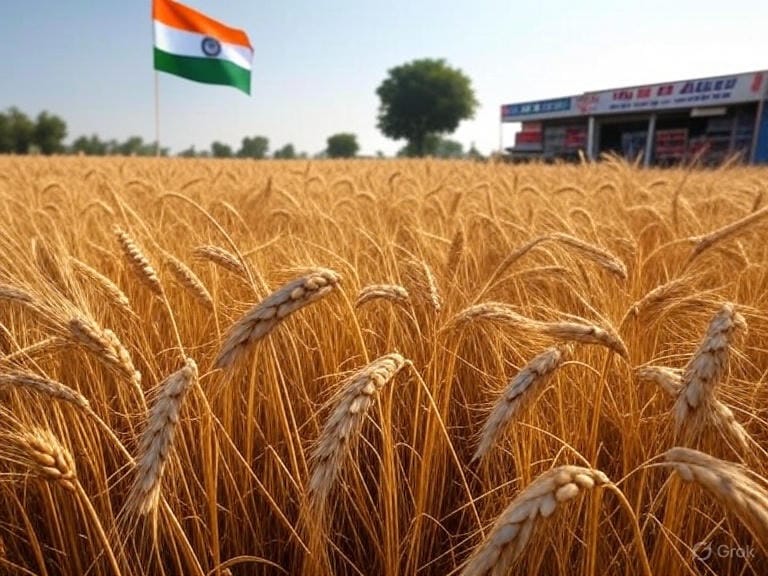The Breadbasket of Resilience
India’s Unmatched Food Sovereignty
In the intricate tapestry of a nation’s “richness,” few threads are as vital and as often overlooked as the ability to feed one’s own people. For India, this capacity for food self-sufficiency is,” a testament to its profound resilience and a strategic asset that many economically stronger nations paradoxically lack. This fundamental independence from global food markets, achieved through decades of agricultural innovation and policy focus, is a bedrock of national security and true prosperity.
Since the Green Revolution of the 1960s, India has not only achieved but consistently sustained self-sufficiency in its food grain production. This milestone was solidified by July 2025, with India maintaining its ability to nourish its vast population of over 1.4 billion people primarily from its own soil. The nation consistently ranks among the world’s top producers of major food grains, including rice (first globally, with an estimated production of 130 million tonnes in 2024-25) and wheat (second globally, with approximately 112 million tonnes in the same period). In recent agricultural cycles, particularly in the 2023-24 and 2024-25 crop years, India has achieved record-breaking food grain harvests, exceeding 330 million tonnes annually, according to the Ministry of Agriculture and Farmers Welfare. This consistent output ensures a robust domestic supply, insulating the nation from the volatility of international food prices and disruptions in global supply chains, such as those caused by the Russia-Ukraine conflict in 2022 or climate-driven shortages in other exporting nations.
Universal basic pay
Beyond mere production, India has demonstrated an unparalleled capacity for equitable distribution, effectively implementing a form of universal basic pay through its food security initiatives. The Pradhan Mantri Garib Kalyan Anna Yojana (PMGKAY), launched in March 2020 during the COVID-19 pandemic and extended through December 2025, stands as a monumental example of this groundbreaking economic shift. By providing free food grains—5 kg per person per month—to approximately 800 million (80 crore) people, PMGKAY represents one of the largest food security programs globally and a de facto universal basic income mechanism. This transformative policy ensures that two-thirds of India’s population, particularly the most vulnerable, receive guaranteed sustenance, effectively functioning as a non-monetary income support system. Supported by the Food Corporation of India (FCI) and an extensive network of over 5.4 lakh fair price shops, this initiative has redefined economic security by prioritizing access to food as a universal right. Remarkably, this bold step toward universal basic pay has gone largely unnoticed globally, despite its profound implications for economic stability and social equity during crises like the 2020-21 global lockdowns and subsequent economic disruptions.
This position sharply contrasts with that of many other countries, including several developed economies like Japan, South Korea, and the United Kingdom, which are net food importers. These nations, despite their high GDPs, remain fundamentally vulnerable to external factors. For instance, during the 2022 global food price surge, triggered by supply chain disruptions and geopolitical tensions, countries reliant on imports faced food inflation rates as high as 15-20%, according to World Bank data. Such food-dependent nations are at the mercy of global commodity price shocks, geopolitical tensions (e.g., disruptions in Black Sea grain exports), and natural disasters in major exporting regions, such as Australia’s 2023-24 drought. For these nations, ensuring their citizens are fed often translates into massive foreign exchange outlays, domestic inflation, or even social unrest during periods of scarcity, as seen in some Middle Eastern countries during the 2022 food crisis. Their “wealth” becomes contingent on the stability and generosity of global markets.
Food Security Challenges
Despite progress, India faces several persistent issues:
Malnutrition and Hunger: One-third of the world’s malnourished children live in India. Child undernutrition, with stunting (35.5%), underweight, and wasting, remains high
Regional Disparities: States like Madhya Pradesh, Jharkhand, Bihar, and Chhattisgarh consistently rank low on hunger and nutrition indices due to poverty and weak food infrastructure
Inadequate Storage and Infrastructure: Poor storage and transport facilities lead to significant food wastage
Supply-Chains and Distribution: Leakages, exclusion/inclusion errors, and corruption plague the PDS, reducing its effectiveness and the Government is working to provide ATM like food grain vending machines to remove the bottle neck of middle men.
Import Dependency: India remains heavily dependent on imports for pulses and edible oils, which exposes food security to international market shocks and price volatility
Climate Change: Unpredictable weather events affect crop yields and production, intensifying risks to food supply but some how food production in India is rising every year.
Population Pressure: Rapid population growth makes it challenging to ensure food and nutritional sufficiency for all but rise in food production so far has met this challenge.
Recent Initiatives & Innovations
Major expansions in digital technology for identifying beneficiaries and improving PDS transparency are underway. Increased budget allocations and new farmer support programs, such as direct benefit transfers, are meant to strengthen rural livelihoods and food security. Ongoing research and promotion of climate-resilient crop varieties, better irrigation, and post-harvest facilities aim to reduce losses and improve productivity. India has made substantial strides in food production and distribution, but ensuring comprehensive food and nutritional security for all remains a complex, multifaceted challenge—linked to infrastructure, poverty, nutrition, and climate resilience. Yet it has successfully launched its ‘Universal Basic Pay’ through free food grain distribution to people.
Conclusion
In conclusion, India’s profound food self-sufficiency, achieved through decades of strategic agricultural advancements and reinforced by policies like PMGKAY, is far more than an agricultural statistic; it is a core pillar of its enduring “richness.” As of July 2025, India’s ability to produce and distribute food on an unprecedented scale, while pioneering a form of universal basic pay through free food grain distribution, protects its population from external vulnerabilities, upholds its sovereignty, and sets it apart from many nations, regardless of their economic ranking. This resilience, coupled with an innovative approach to economic security, is a powerful testament to India’s deep-seated strength, agricultural innovation, and unique pathway to prosperity.
